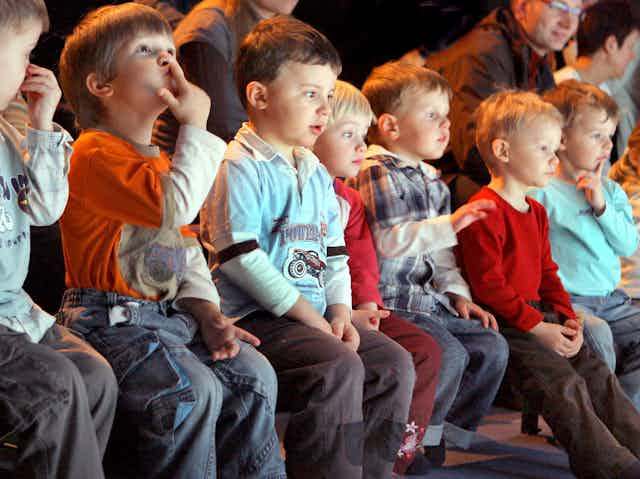Children’s theatre doesn’t often make headlines, but it did last month when Rabbits, a co-production by Opera Australia and Perth’s Barking Gecko Theatre Company, collected four Helpmann Awards: Best New Australian Work, Best Presentation for Children, Best Costume Design, and Best Original Score.
Based on the book by John Marsden, illustrated by Shaun Tan and featuring music by Kate Miller-Heidke and a libretto by Lally Katz, the work premiered at Perth Festival in February to rave reviews. In October, it will be staged at the Melbourne Festival.

The acclaim Rabbits has received provides a chance to celebrate the innovative, clever and dynamic work of children’s theatre companies around the country. It’s also an opportunity to consider the role of theatre in engaging our youngest and, arguably, our most important audiences, and the way recent changes to arts funding may impact on its production.
Australia’s children’s theatre
If you don’t have children or an interest in the field, you might not know that children’s theatre companies such as Windmill Theatre, Patch Theatre, Polyglot Theatre and Slingsby make some of Australia’s finest theatre. Their productions regularly appear on the international festival circuit, collecting awards and cementing Australia’s reputation as a pioneer of dynamic work.
In recent years theatre for babies, such as How High the Sky by Polyglot Theatre, and Rain: for babies and their carers by independent company Drop Bear Theatre, has been leading the way in creating interactive multi-art form experiences.

The major funded companies represent only a small proportion of the theatre made for children in Australia. There hasn’t been a national review of theatre for young people since a 2005 Australia Council for the Arts report on touring children’s theatre by Ian Roberts. A search of arts centre, festival and school touring programs suggests that the majority of children’s theatre is still created and performed by individuals, partnerships and small collectives.
Like the larger companies’ more visible productions, independent children’s theatre is often highly skilled, lovingly made and carefully tailored to its audience. Standout productions in recent years include Nests by Gillian Howell, Ken Evans and Rebecca Russell, and Squaring the Wheel by Jens Altheimer.
This work may be excellent but a lot of it doesn’t fit the draft guidelines for the National Program for Excellence in the Arts (NPEA) because it is made by individuals. At this stage, collectives may be eligible to apply for funding but this is yet to be confirmed by the minister in the final guidelines.
Life as an independent children’s theatre maker
Although independent children’s theatre isn’t heavily publicised, it’s around, if you know where to look – at festivals and in libraries, community arts centres, schools, kindergartens, outdoor public spaces, small theatres and museums.
Artists mostly create this type of theatre in their own time and out of their own pockets. They usually do all the administration, marketing and production management tasks themselves.

None receive ongoing operational funding and they are often paid meagre fees by venues and programmers. Their work is unlikely to attract philanthropic sponsorship (another assessment criterion of the NPEA) because it doesn’t have a high public profile.
Individual artists also lack the time to chase up this kind of financial support. If they apply for project funding from state or federal funding bodies they spend many unpaid weeks writing grant applications, knowing that the pool of money is too small for the number of worthy applications.
That pool has become smaller with the NPEA taking A$104.7 million from the Australia Council for the Arts’ budget over four years.
Children’s access to theatre
Children aren’t mentioned in the draft guidelines for the NPEA, either as creators or audiences. This is curious given that they make up roughly a fifth of the Australian population. “Audience appeal and demand” is one of the assessment criteria for this funding but blunt interpretations of this phrase can disadvantage child audiences.
Their demand for theatre is usually moderated by adults, who make bookings and pay for tickets on their behalf. The 2014 Australia Council report on arts participation, Arts in Daily Life: Australian Participation in the Arts , found that adults who were not taken to arts events as children participate in the arts much less than adults who had regular arts experiences when they were young.

Many children do not experience theatre because their families or schools don’t know about it, are not interested in it, or cannot access it because of cost or distance.
In the past, large numbers of children have been involved in theatre in other ways, such as by participating in school incursions or youth theatre, which has long been recognised as a power house of theatrical innovation. Most of this work is delivered by independent artists. As funding is directed away from these programs, artists find it harder to survive and children’s access to theatre is reduced both now and in their future lives as adults.
How should arts policy be made?
The Arts in Daily Life report also found that 66% of Australians think the arts are important for child development, and 89% think arts education should be part of every Australian’s life. These are significant findings to ignore. But that’s the problem with the NPEA: it does not seem to be based on research or proper consultation.
Senator Brandis has said that an impetus for establishing the program was the number of artists who have complained to him that their work is not eligible for Australia Council funding or has been repeatedly rejected.
But if there are problems with the Australia Council’s eligibility guidelines or its implementation of peer assessment wouldn’t it be better to find out how to fix them rather than to set up a new funding body at great cost?
By embarking on an arts funding policy that ignores history, research and consultation, the government puts pressure on artists’ livelihoods and threatens the richness of children’s cultural lives.

